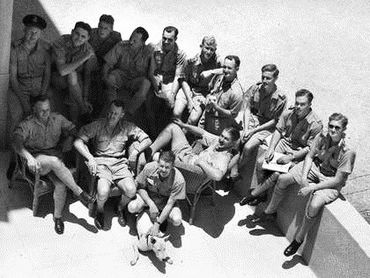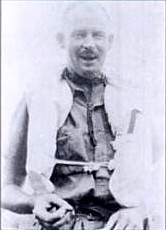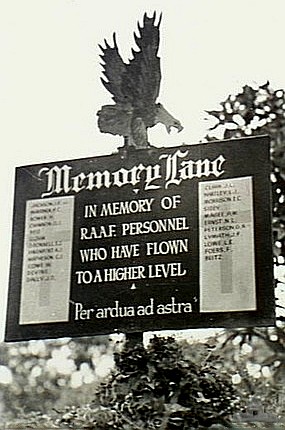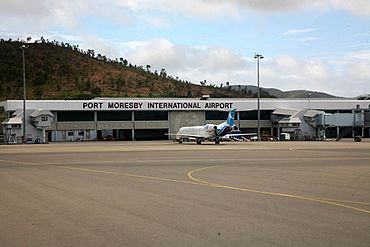John Francis Jackson facts for kids
Quick facts for kids
John Francis Jackson
|
|
|---|---|
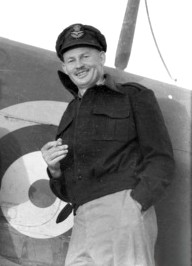
Flight Lieutenant Jackson in North Africa, 1941
|
|
| Nickname(s) | "Old John" |
| Born | 23 February 1908 Brisbane, Queensland |
| Died | 28 April 1942 (aged 34) Port Moresby, Territory of Papua |
| Allegiance | Australia |
| Service/ |
Royal Australian Air Force |
| Years of service | 1936–1942 |
| Rank | Squadron Leader |
| Unit |
|
| Commands held | No. 75 Squadron (1942) |
| Battles/wars | World War II
|
| Awards |
|
| Relations | Les Jackson (brother) |
| Other work | Grazier, businessman |
John Francis Jackson, who earned the DFC, was an Australian fighter pilot and leader during World War II. He was born in Brisbane on February 23, 1908, and sadly died on April 28, 1942. John Jackson was famous for shooting down eight enemy planes. He also led No. 75 Squadron during the important Battle of Port Moresby in 1942. Before the war, he was a farmer and businessman who even owned his own plane. He joined the Royal Australian Air Force (RAAF) Reserve in 1936. When the war started in 1939, he joined active service. He flew with No. 23 Squadron in Australia. Later, he went to the Middle East in November 1940. As a fighter pilot with No. 3 Squadron, he flew planes like the Gloster Gladiators, Hawker Hurricanes, and P-40 Tomahawks. He fought in the North African and Syria–Lebanon campaigns.
Jackson received the Distinguished Flying Cross for his brave actions in the Middle East. He was also mentioned in official reports for his courage. Later, he was sent to the South West Pacific. In March 1942, he was promoted to squadron leader and took command of No. 75 Squadron. This squadron flew P-40 Kittyhawks from Port Moresby in Papua. His friends called him "Old John" because he was 34, which was considered older for a fighter pilot. He was praised for his amazing leadership during the defence of Port Moresby. He died in combat on April 28, 1942. His younger brother, Les, then took over No. 75 Squadron and also became a fighter ace. Today, Jacksons International Airport in Port Moresby is named in John Jackson's honour.
Contents
Early Life and Joining the Air Force
John Jackson was born in New Farm, a suburb of Brisbane, Queensland, on February 23, 1908. He was the oldest son of William and Edith Jackson. He went to Brisbane Grammar School and The Scots College. After school, he worked on a farm in St George.
In the early 1930s, he became a businessman. He was inspired by the MacRobertson Air Race in 1934 to start flying. He bought his own plane, a Klemm Swallow. In 1936, he flew in a race from Brisbane to Adelaide. In August of that year, he joined the Royal Australian Air Force (RAAF) Reserve. In 1937, he bought an even faster plane, a Beechcraft Model 17 Staggerwing.
On February 17, 1938, John married Elisabeth Thompson. They had a son and a daughter. When World War II began, John was called to active duty. He became a pilot officer in the RAAF on October 2, 1939. His younger brother Arthur, who was also a pilot, sadly died in a flying accident that same month. Two other brothers, Edward and Leslie, joined the RAAF in November.
John Jackson first served with No. 23 Squadron in Queensland. This squadron flew CAC Wirraway aircraft. He was promoted to flying officer in April 1940. In October, he was sent to No. 3 (Army Cooperation) Squadron in Egypt. He arrived in the Middle East in November 1940.
Fighting in the War
Middle East Battles
John Jackson first fought with No. 3 Squadron in the North African campaign. He flew a Gloster Gladiator biplane. He was new to air combat but quickly learned. After his unit switched to Hawker Hurricanes, he started winning battles quickly. On February 18, 1941, he shot down three Junkers Ju 87s near Mersa Matruh in one flight!
On April 5, 1941, Jackson attacked a Ju 87. His guns jammed, but he kept making fake attacks. This forced the German plane to crash-land, giving him his fourth victory. Later, No. 3 Squadron started flying P-40 Tomahawks. They then fought in the Syria–Lebanon campaign. Jackson became an ace (meaning he had five or more victories) on June 25. He destroyed a Potez 630 bomber from the Vichy French air force. He also claimed a Dewoitine D.520 fighter on July 10. The next day, he shared in destroying another D.520 with Bobby Gibbes.
Jackson was promoted to flight lieutenant on July 1, 1941. His younger brother Ed was also serving with him in No. 3 Squadron. After the fighting in Syria ended, Jackson returned to Australia in November 1941. He was recognized for his bravery and awarded the Distinguished Flying Cross (DFC). This award was for his "marked keenness and determination" during his time in the Middle East.
Defending the South West Pacific
After returning to Australia, Jackson briefly worked as an instructor. He really wanted to go back to combat. In January 1942, he was sent to No. 4 Squadron in Canberra.
As Japanese forces moved closer to New Guinea in early 1942, the RAAF quickly formed new fighter units. These included Nos. 75, 76, and 77 Squadrons. John Jackson was promoted to acting squadron leader. He was made the commanding officer (CO) of No. 75 Squadron on March 19. This was just two weeks after the squadron was formed in Townsville, Queensland. He took over from Wing Commander Peter Jeffrey. Jeffrey had been preparing No. 75 for operations in Port Moresby. Port Moresby was under constant attack by Japanese bombers.
On March 21, Jackson led the main part of the squadron to Seven Mile Aerodrome. They were there to defend Port Moresby. This was a very important early battle in the New Guinea campaign. The squadron flew P-40 Kittyhawks. Jackson was 34 years old, which was old for a fighter pilot. His men affectionately called him "Old John." His younger brother Les was also a flight lieutenant in the squadron. Jackson's leadership was a huge inspiration to his pilots. Many of them had only nine days of training in fighter tactics.
On March 22, the day after arriving in New Guinea, Jackson led No. 75 Squadron on a surprise attack. They raided the Japanese airfield at Lae. Jackson led the Kittyhawks from the east, where they would not be expected. The rising sun also helped hide their approach. Jackson made two passes over the airfield, even though it was risky. The Australians claimed to have destroyed twelve Japanese planes on the ground. They also shot down two Mitsubishi Zero fighters in the air.
The Japanese attacked back the next day. Jackson's squadron suffered losses, but he refused to pull back. On April 4, Jackson flew a solo mission over Lae. Then, he led four more Kittyhawks on another raid against the airfield. They claimed to destroy seven enemy aircraft on the ground without any losses for themselves. Two days later, Les Jackson had to ditch his plane in the sea. John dropped a life jacket to him, not knowing it was his brother. Les made it to shore safely.
John Jackson himself had to ditch his plane in the sea on April 10. He was shot down by three Zeros near Lae. He pretended to be dead next to his crashed plane to avoid being shot again. Then, he swam to shore and walked through the jungle for over a week. Two local New Guinea natives helped him. When he returned to Port Moresby on April 23, a Japanese air raid was happening. A bullet cut the tip of his right index finger. He called it "a mere scratch."
On April 27, Jackson met with his pilots. Some senior RAAF officers were unhappy that No. 75 Squadron was avoiding dogfights with the Japanese Zeros. Jackson and his men usually avoided these fights because Zeros were better than Kittyhawks in close combat. Jackson felt challenged by the officers' comments. He told his pilots, "Tomorrow I'm going to show you how." The next day, Jackson led No. 75 Squadron's five remaining Kittyhawks to fight Japanese bombers and their escorts. He destroyed an enemy fighter. Then, he was shot down and killed. His plane crashed into a mountain. He was identified only by his boots and his revolver. He had eight aerial victories during the war.
Lasting Impact
Les Jackson, John's brother, took command of No. 75 Squadron the day after John was killed. Even though the squadron was weakened, it had successfully stopped Japan's air attacks on Port Moresby. The town remained an important Allied base.
John Jackson was survived by his wife and children. He was buried in Moresby's Bomana War Cemetery. His name is on panel 104 at the Australian War Memorial (AWM) in Canberra. Jackson enjoyed making amateur films. The AWM has a four-minute film he shot in Port Moresby. Port Moresby's Seven Mile Aerodrome was renamed Jackson's Strip in his honour. It later became Jacksons International Airport.
In 2003, the town of St George built a monument to Jackson. It also honours another local RAAF pilot, Len Waters. John Jackson's leadership and sacrifice were very important to No. 75 Squadron's success.


